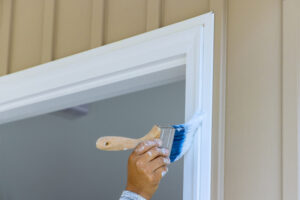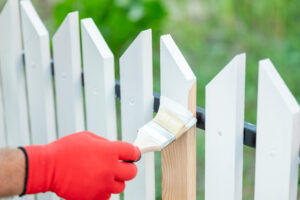
Best Paint for Trim and Baseboards
Baseboards and trim can elevate the appearance of your home’s interior, but even the most ornate trim piece will look dilapidated if it is not
Do I need to use primer when painting? This is a question that many homeowners ask themselves when they’re working on a painting project at home. Painting a new piece of furniture or a blank wall can seem pretty simple. You might think you just need to slap some paint on it and then you’ll be done. However, if you want an even finish and professional-looking result that will sustain some wear and tear, you’re going to want to use a primer before you paint. If you’re relatively new to DIY projects or home improvement projects, it is possible that you’ve never used a primer before. Luckily, this article will break down the basics of using primer for you.
So what is primer anyways? Primer is a preparatory coat that goes on any surface before paint is applied. It helps the compounds in the paint to properly adhere to the surface. This is essential if you want an easy paint job since primer will help to prevent you from having to do countless coats of paint. Primer can help your paint to look vibrant and finished in only a few coats. Primer also helps the paint to go on smoothly and evenly, giving a satisfying finish when the paint is all dried. This is important if you want a durable finish that will protect your walls or furniture from possible damage, scratches, or dings. And let’s be honest, these types of damage happen more easily than you might think. They’re just a part of life, especially when you have pets or kids around.
Using primer during the painting process will help to protect all of the time and effort that you’ve put into the paint job. If you don’t add a coat of primer to the piece that you’re painting, the dried paint on your surface can chip off more easily and it can also be more easily scratched. For example, if you’ve just painted a piece of furniture and need to move it into your house, painting it with primer will protect it from any dings that could quickly damage your newly painted furniture. Adding a coat of primer can also help you to successfully refinish a piece of furniture that needs a new look. Some materials might have previous paint jobs, stains, or finishes that can make it difficult to get a thorough paint job completed. Painting on top of these previous finishes can make your paint job look sloppy and goopy. The paint can also come off very easily if the furniture is bumped. This is one of the reasons why it is so important to use primer when you’re painting, especially if the object you’re painting is used or refurbished.
Imagine you’ve just found the perfect paint color to refinish that old heirloom hutch that has been handed down to you from your great-grandmother. Your new, trendy paint color will bring this hutch into the right century, making it something you’re actually proud of displaying in your home. However, you don’t want to put all the time and effort into painting your piece of furniture (that is totally unique and irreplaceable, by the way) if you’re not sure that the paint is going to stick. This is an example of the perfect circumstance when you should use a primer before you paint. You should use a primer if…
It is a little different when you try to determine if you need to use primer when you’re painting walls. If you’re going to paint a wall that is already smooth and prepped for a paint job, you might not need to use a primer. If it has a vibrant coat of paint, dings, sticky substances, imperfections, or textures that need to be fixed before you add paint, then primer can help you in that process. Even if your kids used your walls as their art project and scrawled drawings all over them, primer can help you to get rid of those messes. For example, if you’ve moved into an older house that used to have wallpaper, you should definitely plan on using a primer, as some adhesive substances might be left over after you’ve scraped or peeled off the old wallpaper. Primer can also be helpful when you’re trying to change the paint color on your walls. If the previous paint color was too dark, vibrant, or glossy, using a primer before you paint can help to prepare your wall for a fresh coat of paint. Going from dark paint to light paint can be a long, strenuous process without primer since you’ll have to add countless coats of paint. Luckily, primer can make this so much easier.
So now that you know that you shouldn’t start any paint job without using some primer, you’re probably wondering what type of primer you should use. Keep in mind that some types of paints are self-priming, so you won’t need to use primer with those brands. While self-priming paints might be more expensive, they take one step out of your painting process! If you know you’ll need primer, here are a few different types of paint primers.
Regardless of what type of primer you need, you should look for a paint primer that has zero or low VOC levels to prevent any unwanted chemicals from being released into the air in your home. Certain brands, like Vista Paint, provide various options for paint primers with zero VOC levels to give you the peace of mind you need.

Baseboards and trim can elevate the appearance of your home’s interior, but even the most ornate trim piece will look dilapidated if it is not

You’ve just installed your beautiful new fence! Now, while it cures, you have the difficult decision of choosing a stain or paint color. With all

How to Find the Right Color for Your Interior Paint Job Have you procrastinated painting the walls in your home because you’re worried you won’t

Baseboards and trim can elevate the appearance of your home’s interior, but even the most ornate trim piece will look dilapidated if it is not

You’ve just installed your beautiful new fence! Now, while it cures, you have the difficult decision of choosing a stain or paint color. With all